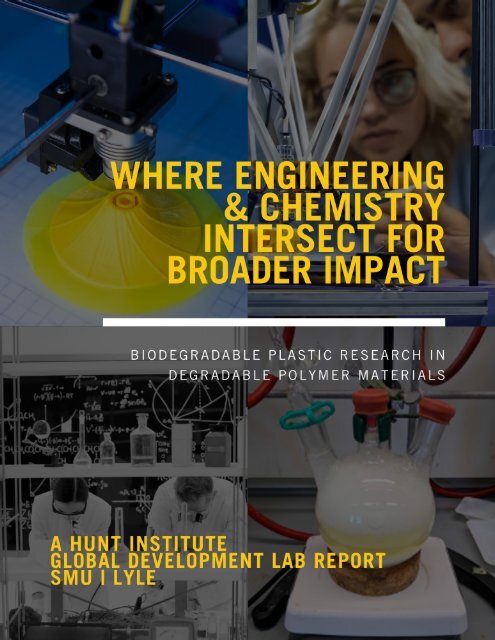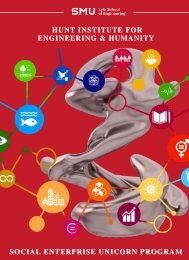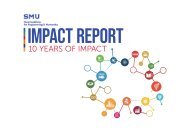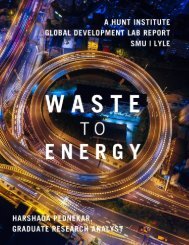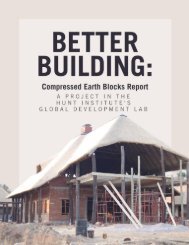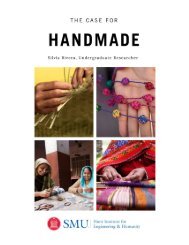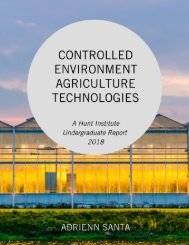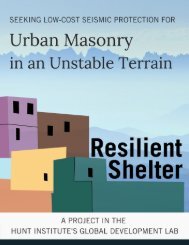Where Engineering & Chemistry Intersect for Broader Impact
Currently, many biodegradable products in the market are bio-based, such as polysaccharides, proteins, and lipids, and are focused on conventional plastic applications. This approach to production of biodegradable plastics, however, is facing mounting challenges due to high cost, weaker performance, and environmental issues. In addition, several biodegradable plastics have proven to break down quickly under specific, simulated environmental conditions, but they may not be effectively degradable under natural conditions. As a result of these challenges and many more, there exists a gap in the market. Our Project Affiliates, Dr. Son and Dr. Krueger, aim to bridge this gap by pursuing a biodegradable plastic that better addresses the aforementioned challenges, investigating a prototype plastic with predictable degradation and mechanical properties. In the spirit of interdisciplinary innovation, they seek to develop a joint chemical and engineering approach to biodegradable plastics for broader impact.
Currently, many biodegradable products in the market are bio-based, such as polysaccharides, proteins, and lipids, and are focused on conventional plastic applications. This approach to production of biodegradable plastics, however, is facing mounting challenges due to high cost, weaker performance, and environmental issues. In addition, several biodegradable plastics have proven to break down quickly under specific, simulated environmental conditions, but they may not be effectively degradable under natural conditions. As a result of these challenges and many more, there exists a gap in the market.
Our Project Affiliates, Dr. Son and Dr. Krueger, aim to bridge this gap by pursuing a biodegradable plastic that better addresses the aforementioned challenges, investigating a prototype plastic with predictable degradation and mechanical properties. In the spirit of interdisciplinary innovation, they seek to develop a joint chemical and engineering approach to biodegradable plastics for broader impact.
Create successful ePaper yourself
Turn your PDF publications into a flip-book with our unique Google optimized e-Paper software.
2<br />
“As a chemist, I have the capability and knowledge to design a material from the molecular level<br />
up. It’s a challenge to synthesize a material with the ‘right’ properties. You can prepare a<br />
material cheaply, but it may not degrade. Or you can make a material that degrades too<br />
quickly or is not 3D-printable. In today’s world, the plastics disposal problem is not going away<br />
anytime soon, and it is exciting that Professor Krueger and our labs can help make a<br />
difference.”<br />
- Dr. David Son<br />
“Material properties are important <strong>for</strong> durability and functionality of engineered systems. But<br />
they are also important <strong>for</strong> what happens when you are finished using the system. Having<br />
materials that can fulfill their design role as well as existing materials and can also easily<br />
degrade to facilitate future disposal is extremely valuable, but difficult to achieve. It’s a pleasure<br />
working with Prof. Son to achieve this dream and help to reduce plastic waste.”<br />
- Dr. Paul Krueger<br />
WHERE ENGINEERING & CHEMISTRY INTERSECT FOR BROADER IMPACT<br />
NGUYEN, KATIE
3<br />
Undergraduate Research Analyst:<br />
Katie Nguyen<br />
Contributing Editors:<br />
Sam Borton & Corrie A. Harris, M.A., M.B.A.<br />
Undergraduate Project Managers:<br />
Sydney Lobato and Taylor Grace<br />
Undergraduate Lab Researchers:<br />
Son Lab: Anderson Wey and Jamie Hall<br />
Krueger Lab: Sami Streb<br />
Global Development Lab Portfolio Manager:<br />
Corrie A. Harris, M.A., MBA<br />
Hunt Institute Affiliates:<br />
Dr. David Son and Dr. Paul Krueger<br />
Southern Methodist University | Lyle School of <strong>Engineering</strong><br />
Hunter and Stephanie Hunt Institute <strong>for</strong> <strong>Engineering</strong> & Humanity<br />
Global Development Lab<br />
Summer 2020 - 2021<br />
WHERE ENGINEERING & CHEMISTRY INTERSECT FOR BROADER IMPACT<br />
NGUYEN, KATIE
4<br />
Table of Contents<br />
Table of Figures ________________________________________________________________ 5<br />
Executive Summary _____________________________________________________________ 6<br />
Global Plastic Waste ____________________________________________________________ 8<br />
Plastic Medical Waste ________________________________________________________________ 9<br />
Environmental Waste due to COVID-19 __________________________________________________ 11<br />
Biodegradable Plastics Industry __________________________________________________ 14<br />
Plastics in the Medical Sphere _________________________________________________________ 14<br />
Biodegradable Supply & Demand ______________________________________________________ 15<br />
Biodegradable Market Trajectory ______________________________________________________ 16<br />
Our Biodegradable Research _____________________________________________________ 19<br />
Dr. David Son Lab ___________________________________________________________________ 19<br />
The Dr. Paul Krueger Lab _____________________________________________________________ 21<br />
Progress Summary - Fall 2020 _________________________________________________________ 22<br />
Recommendations _____________________________________________________________ 26<br />
Appendix A ___________________________________________________________________ 27<br />
Covid-19 Specific Findings ____________________________________________________________ 27<br />
Appendix B ___________________________________________________________________ 31<br />
Plastic Bags and Single-use Plastic Items _________________________________________________ 31<br />
Works Cited __________________________________________________________________ 33<br />
WHERE ENGINEERING & CHEMISTRY INTERSECT FOR BROADER IMPACT<br />
NGUYEN, KATIE
5<br />
Table of Figures<br />
Figure 1: How Plastic Enters the World’s Oceans (Our World in Data) ____________________________________ 8<br />
Figure 2: Environmental activist Gary Stokes collected dozens of discarded masks from a Hong Kong beach (Oceans<br />
Asia) ______________________________________________________________________________________ 12<br />
Figure 3: Projected medical plastics market by region (marketsandmarkets.com)__________________________ 17<br />
Figure 4: Global Protective Face Masks Market (gminsights.com) ______________________________________ 18<br />
Figure 5: Experimental setup <strong>for</strong> monomer synthesis ________________________________________________ 22<br />
Figure 6: Circular mold (left) and plastic (right) _____________________________________________________ 23<br />
Figure 7: Dog bone-shaped plastic in a silicone mold ________________________________________________ 23<br />
Figure 8: (Right) freshly prepared plastic; (Left) plastic after exposure to room environment <strong>for</strong> several weeks __ 24<br />
Figure 9: Tensile test results <strong>for</strong> dog-bone test sample _______________________________________________ 25<br />
Figure 10: Number of cases reported each day in the U.S. since the beginning of the COVID-19 outbreak (cdc.gov) 27<br />
Figure 11: PPE found on beaches and in oceans. (OceansAsia.org, Naomi Brannan) _______________________ 30<br />
WHERE ENGINEERING & CHEMISTRY INTERSECT FOR BROADER IMPACT<br />
NGUYEN, KATIE
6<br />
Executive Summary<br />
In the Hunter and Stephanie Hunt Institute <strong>for</strong> <strong>Engineering</strong> and Humanity’s Global<br />
Development Lab, our interdisciplinary teams made up of students, fellows, faculty, and<br />
industry professionals are working to create meaningful solutions to promote a resilient<br />
humanity, all of which address the UN Sustainable Development Goals (SDGs). This<br />
report addresses biodegradable plastics where engineering and chemistry intersect.<br />
Currently, many biodegradable products in the market are bio-based, such as<br />
polysaccharides, proteins, and lipids, and are focused on conventional plastic<br />
applications. This approach to production of biodegradable plastics, however, is facing<br />
mounting challenges due to high cost, weaker per<strong>for</strong>mance, and environmental issues.<br />
In addition, several biodegradable plastics have proven to break down quickly under<br />
specific, simulated environmental conditions, but they may not be effectively degradable<br />
under natural conditions. As a result of these challenges and many more, there exists a<br />
gap in the market.<br />
Our Project Affiliates, Dr. Son and Dr. Krueger, aim to bridge this gap by pursuing a<br />
biodegradable plastic that better addresses the a<strong>for</strong>ementioned challenges, investigating<br />
a prototype plastic with predictable degradation and mechanical properties. In the spirit<br />
of interdisciplinary innovation, they seek to develop a joint chemical and engineering<br />
approach to biodegradable plastics <strong>for</strong> broader impact.<br />
There are many uses <strong>for</strong> biodegradable plastics to address our current state of<br />
plastics pollution. One potential future application could be biodegradable plastic<br />
used in combination with 3-D printing technology specifically designed <strong>for</strong> use with<br />
WHERE ENGINEERING & CHEMISTRY INTERSECT FOR BROADER IMPACT<br />
NGUYEN, KATIE
7<br />
the unique geometric properties of the biodegradable prototype plastic. Compatibility with<br />
3D printing methods would help to facilitate biodegradable plastic’s replacing of other less<br />
desirable materials, especially given its rapidly growing adoption and application <strong>for</strong><br />
manufacturing both prototype and production components. The lab is developing a 3D<br />
printing technology (extrude and cure additive manufacturing, or ECAM) that can<br />
simultaneously print and cure thermoset polymers such as those considered in this<br />
project.<br />
Another significant opportunity <strong>for</strong> the biodegradable plastic industry is an application<br />
towards alleviating medical waste. Focusing on both producing better-quality medical<br />
supplies and reducing the end-of-life waste associated with such products, this<br />
application works toward both the third UN SDG “to ensure healthy lives and promote<br />
wellbeing <strong>for</strong> all at all ages” and the fourteenth UN SDG, which aims “to conserve and<br />
sustainably use the oceans, seas, and marine resources.” [1]<br />
In order to address this challenge, our team of multidisciplinary students and subject<br />
matter experts have been working diligently to develop a biodegradable plastic with<br />
more desirable characteristics and predictable degradation properties that could both<br />
address medical waste and potentially be used in 3D printing. The remainder of<br />
this report will provide a market analysis of biodegradable plastics, a discussion of their<br />
applications, and updates from the labs progress in their research.<br />
WHERE ENGINEERING & CHEMISTRY INTERSECT FOR BROADER IMPACT<br />
NGUYEN, KATIE
8<br />
Global Plastic Waste<br />
The increasing environmental concern surrounding the use of traditional plastic<br />
materials has resulted in a demand <strong>for</strong> industry and academia to research and<br />
provide innovation in order to develop sustainable solutions.<br />
The growing amount of un-recycled plastic has created serious pollution and<br />
environmental damage globally since the 1960s. [2] Plastic waste build-up in oceans has<br />
captured the public’s attention. In 2018, China announced it would no longer buy twothirds<br />
of the world’s waste. The impact of China no longer managing this waste is the<br />
displacement of as much as 111 million metric tons of plastic waste by 2030. [3] This<br />
resulted in an increase of waste management facilities disposing plastic waste in landfills,<br />
marine sites, or incinerators, as shown in Figure 1.<br />
Figure 1: How Plastic Enters the World’s Oceans (Our World in Data)<br />
WHERE ENGINEERING & CHEMISTRY INTERSECT FOR BROADER IMPACT<br />
NGUYEN, KATIE
9<br />
National Geographic estimates that of the 8.3 billion metric tons of all plastics that<br />
have been produced 6.3 billion metric tons have become plastic waste, a staggering<br />
76%. Out of that waste only 9% is believed to be recycled. The vast majority, ~ 79%, is<br />
accumulating in landfills or sloughing off in the natural environment as litter. [3] Eventually,<br />
plastic waste ends up in the oceans, with an estimate range of 4-12 million metric tons<br />
generated on land entering the marine environment in 2010 alone. [4]<br />
Plastic Medical Waste<br />
The environmental non-profit Health Care Without Harm estimates that the world’s<br />
healthcare industry contributes to just over 4% of the world’s emissions, much of that from<br />
round-the-clock care. [5] While hospitals will most likely not reach a zero-waste state, the<br />
facilities can reduce plastic waste, equally promoting wellness and sustainability.<br />
Plastics are hygienic, versatile, and af<strong>for</strong>dable. They have long been essential,<br />
keeping hospitals running, supporting the care of patients, and ensuring front-line workers<br />
stay safe. Healthcare facilities in the United States generate approximately 14,000 tons<br />
of waste per day, many of which are incinerated or left in landfills. [6] Plastics represent 20-<br />
25% of the total waste portion of the medical waste, which is significantly higher than that<br />
of municipality solid waste. [7] ~ 3,150 tons a day equates to ~1,149,750 tons of medical<br />
plastic waste annually.<br />
Untreated health care waste is typically processed in landfills or incineration.<br />
Disposing untreated health care waste in landfills can lead to contamination of drinking,<br />
surface, and ground waters, along with the soil and the air, if those landfills are not<br />
scientifically constructed. [8]<br />
Incineration of waste has been widely practiced but<br />
WHERE ENGINEERING & CHEMISTRY INTERSECT FOR BROADER IMPACT<br />
NGUYEN, KATIE
10<br />
inadequate incineration or the incineration of unsuitable materials results in the release<br />
of pollutants into the air. [9] Specifically, contaminated syringes and needles represent a<br />
particular threat, because disposing of them incorrectly could lead to dangerous recycling<br />
and repackaging or unsafe reuse. All pose as a health threat.<br />
According to the World Health Organization (WHO), “85% of all medical waste is<br />
incinerated even though only 15% of it is considered biohazardous.” [7] In fact, 25% of<br />
healthcare’s annual waste generated from U.S. facilities are clean, noninfectious plastics,<br />
amounting to approximately one million tons per year of valuable polymers that could<br />
potentially be recycled and reused.<br />
With a significant rise in the demand <strong>for</strong> eco-friendly and sustainable products from<br />
end-users in the healthcare industry, the adoption of biodegradable medical plastics is<br />
growing at a rapid pace. As covered previously, hospitals and healthcare centers usually<br />
dispose of the dangerous waste appropriately and send the rest to landfills. However,<br />
WHERE ENGINEERING & CHEMISTRY INTERSECT FOR BROADER IMPACT<br />
NGUYEN, KATIE
11<br />
growing environmental awareness and sustainability among consumers is influencing<br />
manufacturers and end-users to adopt sustainable solutions.<br />
Environmental Waste due to COVID-19<br />
With the need <strong>for</strong> single-use PPE being a central issue during the COVID-19<br />
pandemic, the market <strong>for</strong> biodegradable plastics in the medical industry has greatly<br />
expanded and is relevant to this research (see Appendix A).<br />
In the spring of 2020, the coronavirus pandemic brought a dramatic increase in the<br />
use of plastic, the main component in masks, gloves, hand sanitizer bottles, protective<br />
medical suits, test kits, takeout containers, delivery packaging, and more items central to<br />
the locked-down, hyper-hygienic way of life. Moreover, there are many other plastic items<br />
widely used in medical applications <strong>for</strong> creating a sterile environment, such as pill casings,<br />
disposable syringes, catheters, and blood bags. These items are made of synthetic<br />
polymers such as polyvinyl chloride (PVC) and PP, which are not<br />
biodegradable. [10] There<strong>for</strong>e, it is not surprising to see that there was an increase in<br />
medical waste generated as a result of the COVID-19 pandemic.<br />
WHERE ENGINEERING & CHEMISTRY INTERSECT FOR BROADER IMPACT<br />
NGUYEN, KATIE
12<br />
Figure 2: Environmental activist Gary Stokes collected dozens of discarded masks from a Hong Kong beach<br />
(Oceans Asia)<br />
An additional consequence of the COVID-19 pandemic has been that recycling and<br />
municipal waste services in the U.S. and beyond have been significantly limited, which<br />
means that the excess of plastic might fall into the category of unrecycled. [11] The global<br />
demand <strong>for</strong> certain uses of plastics has increased due to the pandemic. The polymers<br />
used in lifesaving medical equipment, such as N-95 masks, polyethylene used in Tyvek<br />
protective suits, and PET in single-use plastic water bottles and medical face shields have<br />
all seen a rise in demand during the global pandemic.<br />
Officials had to construct a new medical waste plant to combat the influx of medical<br />
waste generated by hospitals in Wuhan, the capital of Hubei Province in the People’s<br />
WHERE ENGINEERING & CHEMISTRY INTERSECT FOR BROADER IMPACT<br />
NGUYEN, KATIE
13<br />
Republic of China, where the coronavirus first emerged. Hospitals there produced six<br />
times as much medical waste at the peak of the outbreak as they did be<strong>for</strong>e the crisis<br />
began. [12] The daily output of medical waste reached 240 metric tons, about the weight of<br />
an adult blue whale.<br />
With the novel coronavirus being a new strain, there was a deficient in standard<br />
operating procedures, insufficient resources, and lack of employee training on how to<br />
handle, manage, and dispose of the virus. This resulted in more materials being managed<br />
through traditional waste processes--incineration and sanitary landfill. The Center <strong>for</strong><br />
Disease Control and Prevention (CDC) says that “medical waste from COVID-19 can be<br />
treated the same way as regular medical waste, that is burning, sterilized with steam, or<br />
chemically disinfected be<strong>for</strong>e going to a sanitary landfill.” [13] However, regulations on how<br />
to treat that waste vary by location and can be governed by state health and<br />
environmental departments, as well as by the Occupational Safety and Health<br />
Administration (OSHA) and the Department of Transportation causing confusion <strong>for</strong> waste<br />
management providers.<br />
While plastics such as gloves, masks, and other medical equipment are important <strong>for</strong><br />
protecting against the spread of the virus, the pandemic serves as a reminder of how<br />
much waste is produced and how it is can be managed or mismanaged. It also shines<br />
light on the need <strong>for</strong> biodegradable plastic alternatives, especially in the medical field.<br />
WHERE ENGINEERING & CHEMISTRY INTERSECT FOR BROADER IMPACT<br />
NGUYEN, KATIE
14<br />
Biodegradable Plastics Industry<br />
Plastics in the Medical Sphere<br />
Medical disposables can be defined as single-use products that are used in surgical<br />
and procedural applications. A fact sheet published by the American <strong>Chemistry</strong> Council,<br />
a plastic trade group, says, “Single-use plastics are the cleanest, most efficient way” to<br />
facilitate health and hygiene in hospitals. [14]<br />
As established in the previous sections, plastic plays an important role within the<br />
health-care sphere. The benefits of plastics are apparent in medicine and public health<br />
due to their versatility, cost-effectiveness, and minimal energy required to produce,<br />
compared to metals and glass. Due to this, polymers are used in various health<br />
applications, such as disposable syringes and intravenous bags, sterile packaging <strong>for</strong><br />
medical instruments as well as joint replacements, tissue engineering, etc.<br />
Currently in the market, alternative products, often biodegradable, are costly to<br />
produce and can be a source of criticism due to their differing waste disposal procedures<br />
and slow decomposition times. One major challenge is to find a plastic alternative that<br />
would degrade swiftly without releasing harmful toxins into the environment and that<br />
would serve as a safe alternative.<br />
Recently, significant progress has been made in the development of biodegradable<br />
materials with similar functionality to that of oil-based polymers, commonly used in<br />
packaging applications. The expansion into these biodegradable materials has potential<br />
benefits <strong>for</strong> greenhouse gas balances and other environmental impacts over whole life<br />
cycles. It is intended that use of biodegradable materials will contribute to sustainability<br />
WHERE ENGINEERING & CHEMISTRY INTERSECT FOR BROADER IMPACT<br />
NGUYEN, KATIE
15<br />
and reduction in the environmental impact associated with disposal of petroleum-based<br />
polymers. Our research seeks to achieve this and beyond. Imagine a biodegradable<br />
plastic that would begin decomposition when introduced to a certain environment, like<br />
water or air.<br />
The global biodegradable plastic market was valued at $4.65 billion in 2019 and is<br />
expected to reach a market value of $12.06 billion by 2025. [15] Based on type, the starch<br />
blend segment accounted <strong>for</strong> two-fifths of the global biodegradable market share in 2018<br />
and is expected to dominate the market through 2026. On the other hand, the segment<br />
<strong>for</strong> polylactic acid plastic (PLA), made from renewable resources, is projected to grow<br />
22.0% YOY annually from 2019 to 2026. [16] The market is driven by the rising income in<br />
emerging economies, high growth in the agriculture and horticulture, packaging and bags,<br />
and the textile industries. As regulations and prohibitions against plastic items (see<br />
Appendix B) are increasing worldwide, the market <strong>for</strong> biodegradable plastics continues to<br />
grow.<br />
Biodegradable Supply & Demand<br />
The production of biodegradable plastics is currently very low: estimated at around 4<br />
million tons per year, which accounts to just over 1 percent of global plastics production. [17]<br />
According to the report, Biodegradable Plastic Market, from Markets and Markets, the<br />
Asia Pacific region is expected to be the fastest growing market <strong>for</strong> biodegradable plastics<br />
with China and India among the fastest growing economies in the world. [18]<br />
Companies such as NatureWorks (US), BASF (Germany), Total Corbion PLA<br />
(Netherlands), Mitsubishi Chemical Corporation (Japan), and Biome Bioplastics (UK) are<br />
WHERE ENGINEERING & CHEMISTRY INTERSECT FOR BROADER IMPACT<br />
NGUYEN, KATIE
16<br />
the major players in the global biodegradable plastics market. These companies are<br />
hoping to strengthen their market position through increased research and design and<br />
technological advancements. They represent the global organizations leading the<br />
biodegradable plastics market overall.<br />
According to the WHO, of the total amount of waste generated by health-care<br />
activities, about “…85% is general, non-hazardous waste while the remaining 15% is<br />
considered hazardous material that may be infectious.” [7] Demand <strong>for</strong> disposable plastic<br />
products, driven by the concern of viral transmission, is skyrocketing due to the global<br />
pandemic starting in 2019. The capacity to safely deal with these materials after use,<br />
however, remains low <strong>for</strong> many reasons that are beyond the scope of this report.<br />
Biodegradable Market Trajectory<br />
Today, the field of biodegradable materials and devices attract scientists and<br />
healthcare professionals in surgery, pharmacology, and regenerative medicine. However,<br />
the number of devices of systems that have been successfully developed <strong>for</strong> clinical and<br />
commercial uses is in its infancy. The biodegradable medical plastics market is expected<br />
to grow by $197.42 million during 2019-2023, according to Technavio. [19]<br />
The North American region led the biodegradable medical plastics market in 2018<br />
with the US as the primary contributor to its growth. As is evident in Figure 5, Markets<br />
and Markets <strong>for</strong>ecasts the market size is projected to grow from $22.8 billion in 2019 to<br />
$31.7 billion by 2024, at a compound annual growth rate (CAGR) of 6.8%. [20] Global<br />
Biodegradable Medical Plastics Market 2019-2023 <strong>for</strong>ecasts a more favorable CAGR <strong>for</strong><br />
WHERE ENGINEERING & CHEMISTRY INTERSECT FOR BROADER IMPACT<br />
NGUYEN, KATIE
17<br />
the global biodegradable medical plastics market with an expected CAGR of more than<br />
11% from 2019-2023. [21]<br />
The use of these medical products in procedural applications and general checkups<br />
is increasing. The medical disposables segment is projected to register the highest CAGR<br />
between 2019 and 2024. In addition, the use of these disposables as instructed by various<br />
agencies, such as USFDA and Europe FDA are propelling the demand <strong>for</strong> medical<br />
plastics globally.<br />
Figure 3: Projected medical plastics market by region (marketsandmarkets.com)<br />
Increased incidences of chronic diseases, a changing lifestyle of the middle-income<br />
group, rising demand <strong>for</strong> better healthcare, and increase in the aging population are the<br />
major drivers <strong>for</strong> the market. Even post-pandemic, it is anticipated that the medical<br />
WHERE ENGINEERING & CHEMISTRY INTERSECT FOR BROADER IMPACT<br />
NGUYEN, KATIE
18<br />
industry will continue to require protective face masks, gowns, and gloves on a regular<br />
basis, there<strong>for</strong>e driving PPE market outlook. [22]<br />
For example, the protective face masks market exceeded $1 billion in 2019 and is<br />
estimated to grow at a CAGR of over 10.1% between 2020 and 2026. [23] N95 respirators<br />
accounted <strong>for</strong> a market value of $ 321.3 million in 2019. N95 respirators are preferred by<br />
medical personnel <strong>for</strong> their protection from 95% of substances larger than 0.03 microns.<br />
The proven efficacy of these respirators in preventing the spread of the virus has boosted<br />
their demand.<br />
Figure 4: Global Protective Face Masks Market (gminsights.com)<br />
WHERE ENGINEERING & CHEMISTRY INTERSECT FOR BROADER IMPACT<br />
NGUYEN, KATIE
19<br />
Our Biodegradable Research<br />
As stated in the executive summary, Dr. David Son and Dr. Paul Krueger collaborate<br />
to work on a project with a joint chemical and engineering approach to biodegradable<br />
plastics <strong>for</strong> broader impact.<br />
Both labs per<strong>for</strong>m research on key topics that include modeling the material<br />
properties, experimentally characterizing the properties <strong>for</strong> degradability, and<br />
investigating ways to optimize the chemical <strong>for</strong>mulation to preserve degradability while<br />
achieving desirable mechanical properties. By combining the knowledge of bioresorbable<br />
polymers and novel biopolymers, the product will stand out with unique mechanical<br />
properties, improved total degradation time, and minimal toxicity released back into the<br />
environment.<br />
Dr. David Son Lab<br />
From a chemical point of view, researchers could take several approaches. They can<br />
develop additives <strong>for</strong> conventional mass-produced polymers that initiate degradation on<br />
exposure to certain stimuli such as light, heat, or moisture. Another approach would be<br />
to utilize bio-based plastics and chemically modify them to impart certain desirable<br />
properties to the material. In the third and most desirable approach, researchers can<br />
design plastics from the molecular level to give predictable properties to the final plastic<br />
material.<br />
Previously, the Center <strong>for</strong> Drug Discovery, Design and Delivery (CD4) on the SMU<br />
campus developed possibilities of in vivo types of applications, such as a temporary<br />
structural feature or as a scaffold <strong>for</strong> tissue growth. The Son Lab within the CD4 has been<br />
WHERE ENGINEERING & CHEMISTRY INTERSECT FOR BROADER IMPACT<br />
NGUYEN, KATIE
20<br />
experimenting with combining thiols and alkenes to create biopolymers that undergo<br />
degradation in physiological conditions and can be precisely controlled over<br />
the degradation response time. With the ability to control the polymer during the time<br />
course, the mechanical properties can be compared in selected systems.<br />
Recently, the lab also demonstrated the creation of a new plastic that degrades on<br />
contact to moisture. The plastic is prepared from custom-made compounds and cures at<br />
moderate temperatures without the need <strong>for</strong> catalysts or other additives. Initially, this lab<br />
research found that the degradation profile of the plastic could be controlled by simple<br />
molecular modifications of the starting compounds.<br />
A large issue that today’s society faces is managing waste as a result of globalization.<br />
Particularly, a key challenge of biodegradable plastics is their need <strong>for</strong> particular waste<br />
management plans, which are not always widely available. This does not mean such<br />
methods are infeasible, but there could be an additional cost especially if they are in the<br />
waste stream at low concentrations, implying significant work in terms of infrastructure<br />
redesign.<br />
Not all bio-based polymers are deemed biodegradable and failing to manage their<br />
disposal would result in uncontrolled biodegradation, adding to existing plastic pollution.<br />
In contrast to the byproducts of many bio-based plastics in the market, the Son Lab has<br />
studied cell toxicity to indicate the degradation byproducts of their new material to be<br />
relatively harmless. With these results, the Son Lab can tailor the degradation properties<br />
of the plastic through molecular modification of the starting materials. The modifications<br />
can also enhance the mechanical properties of the material.<br />
WHERE ENGINEERING & CHEMISTRY INTERSECT FOR BROADER IMPACT<br />
NGUYEN, KATIE
21<br />
The Dr. Paul Krueger Lab<br />
Alternatively, the Krueger lab team works with 3D printing partners to address various<br />
mechanical properties important <strong>for</strong> utilizing the materials in numerous applications.<br />
Important properties include tensile properties (stiffness and maximum elongation at<br />
break) and thermal properties (coefficient of thermal conductivity and expansion).<br />
Adhesive properties will also be analyzed to understand how well materials may be<br />
processed to achieve the desired shape.<br />
A versatile material would not only be degradable to help minimize waste, but would<br />
also have properties that allow it to be broadly adopted in order to displace other less<br />
desirable materials. Compatibility with 3D printing methods would facilitate this given its<br />
rapidly growing adoption and application <strong>for</strong> manufacturing both prototype and production<br />
components. The lab is continuing to develop a 3D printing technology (extrude and cure<br />
additive manufacturing, or ECAM) that can simultaneously print and cure thermoset<br />
polymers such as those considered in this project. Thermosets are more challenging to<br />
work with because, unlike thermoplastics that can be remelted, thermosets retain their<br />
shape once cured.<br />
Several players occupy the market share: Arkema Group and BASF SE have<br />
intensified their competition, and Corbion NV, Evonik Industries AG, and Koninklijke DSM<br />
NV are other major companies. [24] The increasing preference <strong>for</strong> sustainable products and<br />
the aging population will provide significant growth <strong>for</strong> biodegradable medical plastics<br />
manufacturers.<br />
WHERE ENGINEERING & CHEMISTRY INTERSECT FOR BROADER IMPACT<br />
NGUYEN, KATIE
22<br />
Progress Summary - Fall 2020<br />
Researchers Anderson Wey and Jamie Hall optimized the synthesis of the two<br />
monomers required <strong>for</strong> the synthesis of the prototype degradable plastic. Anderson’s<br />
monomer is a furan-based trisubstituted silyl ether, and Jamie’s monomer is a maleimidebased<br />
disubstituted silyl ether. The silyl ether component is key to the degradable<br />
properties as it will cleave on prolonged exposure to moisture. By the end of the summer<br />
of 2020, both Anderson and Jamie had achieved syntheses of their monomers in<br />
laboratory-scale quantities (10–20 grams each). See Figure 5 <strong>for</strong> an example of a<br />
laboratory synthesis setup.<br />
Figure 5: Experimental setup <strong>for</strong> monomer synthesis<br />
Initial network preparations were carried out using a circular aluminum mold provided<br />
by Dr. Krueger’s laboratory in mechanical engineering and designed by the<br />
WHERE ENGINEERING & CHEMISTRY INTERSECT FOR BROADER IMPACT<br />
NGUYEN, KATIE
23<br />
undergraduate researcher, Sami Streb, working in Dr. Krueger’s lab.<br />
Networks<br />
were prepared by mixing Anderson’s and Jamie’s monomers in the mold and heating at<br />
80°C <strong>for</strong> two hours. Network preparation was successful; however, the cured plastics<br />
adhered too strongly to the mold and had to be peeled out, resulting in de<strong>for</strong>mation of the<br />
plastic (Figure 6).<br />
Figure 6: Circular mold (left) and plastic (right)<br />
Sami prepared a mold out of silicone, which proved to release the plastic much<br />
easier. We recently prepared a “dog bone” shaped sample <strong>for</strong> mechanical testing in the<br />
Krueger lab (Figure 7).<br />
Figure 7: Dog bone-shaped plastic in a silicone mold<br />
WHERE ENGINEERING & CHEMISTRY INTERSECT FOR BROADER IMPACT<br />
NGUYEN, KATIE
24<br />
Further attention to degradation measurements will be needed as of the writing of this<br />
report. Researchers observed that the plastics did degrade on prolonged exposure to<br />
ambient conditions (Figure 8).<br />
Figure 8: (Right) freshly prepared plastic; (Left) plastic after exposure to room environment <strong>for</strong> several weeks<br />
Using the dog-bone sample shown in Figure 7, Sami per<strong>for</strong>med a tensile test of the<br />
sample using an Instron tensile testing machine available in the mechanical engineering<br />
department. The stress strain curve obtained from this test is shown in Figure 9. The<br />
sample was tested to failure and showed an ultimate stress of 7.35 MPa and an ultimate<br />
strain of 1.21%.<br />
These values are low compared to typical polymers, which may reflect a more brittle<br />
behavior <strong>for</strong> this material. The material also shows an extended region of plastic<br />
de<strong>for</strong>mation (strain with very little change in stress) followed by another region of elastic<br />
behavior. Additional testing will be needed to confirm the consistency of these results.<br />
WHERE ENGINEERING & CHEMISTRY INTERSECT FOR BROADER IMPACT<br />
NGUYEN, KATIE
25<br />
Figure 9: Tensile test results <strong>for</strong> dog-bone test sample<br />
WHERE ENGINEERING & CHEMISTRY INTERSECT FOR BROADER IMPACT<br />
NGUYEN, KATIE
26<br />
Recommendations<br />
This analysis finds that there is a significant market available <strong>for</strong> biodegradable<br />
plastics industry, especially those with specifically-manipulated degradation<br />
characteristics, towards alleviating plastic waste. Demand exists in the medical industry,<br />
especially when dealing with single-use waste management.<br />
One potential future application could be its use in combination with 3-D printing<br />
specifically designed <strong>for</strong> use with the unique properties of the prototype plastic. Because<br />
of its biodegradable nature, the prototype plastic will also greatly reduce end-of-life<br />
waste. These characteristics are significant advances to the biodegradable<br />
plastics currently leading the market. With the ability to manipulate the plastic’s<br />
properties, they can impart certain desirable characteristics of the material and give the<br />
final product more predictable degradation properties.<br />
Future studies that include use of the degradable polymer material in combination<br />
with 3-D printing and ECAM capabilities have market potential <strong>for</strong> innovation in a broad<br />
range of applications to support a cleaner environment. Focusing on both producing<br />
better-quality medical supplies and reducing the end-of-life waste associated with such<br />
products could be extremely valuable impact on the social, economic, and environmental<br />
aspects of medical plastic waste.<br />
WHERE ENGINEERING & CHEMISTRY INTERSECT FOR BROADER IMPACT<br />
NGUYEN, KATIE
27<br />
Appendix A<br />
Covid-19 Specific Findings<br />
Months into the pandemic, the US faces a shortage of PPE as the number of cases<br />
increases (see Figure 10) and more people are admitted into health care facilities. [25] The<br />
dearth of supplies is affecting a broad array of health facilities, and the supply cannot<br />
keep up with the demand. Many hospitals, nursing homes, and private medical practices<br />
are facing a shortage of respirator masks, isolation gowns, and disposable gloves that<br />
protect front-line medical workers from infection.<br />
Figure 10: Number of cases reported each day in the U.S. since the beginning of the COVID-19 outbreak (cdc.gov)<br />
Doctors at the Memorial City Medical Center in Houston who directly treat COVID-19<br />
patients have been urged to reuse single-use N95 respirator masks <strong>for</strong> up to 15<br />
days be<strong>for</strong>e throwing them out. National Nurses United (NNU), the country’s largest<br />
organization of registered nurses found in a survey of its members in late June that 87%<br />
WHERE ENGINEERING & CHEMISTRY INTERSECT FOR BROADER IMPACT<br />
NGUYEN, KATIE
28<br />
of nurses had been <strong>for</strong>ced to reuse disposable N95 masks while treating infected<br />
patients. [26] In Florida, some hospitals are handing out only loose-fitting surgical masks to<br />
workers treating newly admitted patients who may be asymptomatic carriers.<br />
At GetUsPPE, a volunteer organization that helps health care facilities and workers<br />
find protective gear, demand has been rising sharply in states experiencing a surge of<br />
infections. In June, the amount of PPE requested from medical providers in Iowa jumped<br />
440 percent from the previous month, along with more than 200 percent increases in<br />
Texas and Louisiana. [27]<br />
According to Johns Hopkins University as of August 2020, the number of confirmed<br />
coronavirus cases worldwide is inching towards 15 million with more than 500,000<br />
deaths. [28] The situation is worsening, as the number of cases among frontline healthcare<br />
workers is also steadily rising. The International Council of Nurses (ICN) estimates<br />
that around 90,000 health workers have been infected by the coronavirus, and over 260<br />
nurses have died because of the pandemic. [29] This crisis, there<strong>for</strong>e, has heightened the<br />
need <strong>for</strong> PPE such as gowns, face masks, and goggles. The World Health Organization<br />
responded by urging governments and manufacturers in February 2020 to ramp up their<br />
PPE production by 40%. As the spread of COVID-19 intensifies, the demand <strong>for</strong> PPE is<br />
likely to remain sky-high <strong>for</strong> the remainder of the pandemic.<br />
The fear of equipment shortages comes as other issues that plagued the country’s<br />
early response to the pandemic return: surging cases, overwhelmed hospitals, lagging<br />
testing, and contradictory public health messages. The inability to secure PPE is<br />
especially frustrating, health-care workers say, because it is their main defense against<br />
catching the virus.<br />
WHERE ENGINEERING & CHEMISTRY INTERSECT FOR BROADER IMPACT<br />
NGUYEN, KATIE
29<br />
In 2020, nurses posted online testimonials about a lack of PPE, with some given<br />
surgical masks instead of N95 masks because of shortages. [30] Hospital executives in<br />
Houston — where case numbers continue to break records — have said they have<br />
enough PPE <strong>for</strong> now but expressed worries of running out if cases continue to spike.<br />
Demand <strong>for</strong> protective equipment has soared, but unlike in March, when ef<strong>for</strong>ts focused<br />
on getting PPE <strong>for</strong> major hospitals — especially in New York, Detroit and Chicago —<br />
supplies now are desperately needed in primary care offices, nursing homes, prisons and<br />
psychiatric and disability facilities. As many states continue to reopen their economies,<br />
demand has also surged from the construction industry and other sectors. As a result,<br />
prices have skyrocketed.<br />
Some hospitals say much of the PPE they have acquired has been exorbitantly<br />
priced. At a legislative hearing, a hospital association executive detailed how one<br />
Maryland hospital that spent $600,000 on PPE last year expects to spend $10 million this<br />
year. The struggles have been especially acute <strong>for</strong> small, rural providers, who can’t<br />
compete with bigger health systems’ bigger budgets and larger-scale orders, experts<br />
say. [30]<br />
Outside the medical sphere in homes, offices, schools, and industry to help reduce<br />
the spread of the virus, social distancing rules were introduced with an increase in hand<br />
sanitizer and disposable polyethylene (PE) gloves use. Considering those who are<br />
recovering at home or are asymptomatic, people are generating plenty of infected trash.<br />
For those working in the sanitation industry, it poses a worry as the virus can persist up<br />
to a day on cardboard, but up to 72 hours on plastic. [31] Additionally, massive amounts of<br />
PPE like masks and gloves clog sidewalk drains and are washing into waterways. [32]<br />
WHERE ENGINEERING & CHEMISTRY INTERSECT FOR BROADER IMPACT<br />
NGUYEN, KATIE
30<br />
Figure 11: PPE found on beaches and in oceans. (OceansAsia.org, Naomi Brannan)<br />
WHERE ENGINEERING & CHEMISTRY INTERSECT FOR BROADER IMPACT<br />
NGUYEN, KATIE
31<br />
Appendix B<br />
Plastic Bags and Single-use Plastic Items<br />
With the growing laws and regulations regarding plastic bags and other single-use<br />
plastic items, various government and federal agencies have been promoting<br />
biodegradable plastics to reduce plastic waste, which boosts the demand of this market.<br />
As of July 2018, 127 out of 192 countries (about 66%) have adopted some <strong>for</strong>m of<br />
legislation to regulate plastic bags. [33] Various fast-moving consumer goods (FMCG)<br />
companies, such as PepsiCo, Coca-Cola, and Procter & Gamble, have been required to<br />
adopt biodegradable packaging to comply with the standards, which, as a result, has<br />
propelled the growth of this market. While a number of countries have sought to regulate<br />
marine pollution by banning plastic bags, the bans do not cover the life-cycle of existing<br />
plastic bags -- manufacturing, production, use, distribution, and trade.<br />
In North America, the trend in the U.S. and Canada is towards regulating plastic bags<br />
through sub-national legislation and collaborations between public and private sectors,<br />
with states and cities (as well as major retailers) at the <strong>for</strong>efront of reducing plastic bag<br />
usage and waste. In the U.S., only Cali<strong>for</strong>nia, New York, and Hawaii have<br />
statewide bans on non-biodegradable plastic bags. Six cities have plastic bag bans:<br />
Austin, Boston, Chicago, Los Angeles, San Francisco, and Seattle. Ten states have<br />
outlawed plastic bag bans: Arizona, Florida, Michigan, Wisconsin, Idaho, Minnesota,<br />
Mississippi, Missouri, Indiana, and Iowa.<br />
The result of bans on plastic bags, specifically in Cali<strong>for</strong>nia, have led to an estimated<br />
reduction of 40 million pounds of plastic trash per year. [34] With the reduction of plastic use,<br />
WHERE ENGINEERING & CHEMISTRY INTERSECT FOR BROADER IMPACT<br />
NGUYEN, KATIE
32<br />
consumers are more likely to seek out alternatives that will minimize negative<br />
environmental impact when disposed of, whether in the <strong>for</strong>m of reusable or biodegradable<br />
materials. Imagine the effects on global plastic waste if quality alternatives at an<br />
af<strong>for</strong>dable price were available in all areas of plastic production and use.<br />
Ocean Conservancy scientists worry that if the temporary rollbacks to plastic bans<br />
become permanent, it would undermine ef<strong>for</strong>ts to reduce single-use plastics and increase<br />
ocean plastic pollution going <strong>for</strong>ward. [35]<br />
WHERE ENGINEERING & CHEMISTRY INTERSECT FOR BROADER IMPACT<br />
NGUYEN, KATIE
33<br />
Works Cited<br />
[1]<br />
Oceans – United Nations Sustainable Development. (n.d.). Retrieved 2020,<br />
from https://www.un.org/sustainabledevelopment/oceans/<br />
[2]<br />
Gill, V. (2019, April 16). Early ocean plastic litter traced to 1960s. Retrieved 2020,<br />
from https://www.bbc.com/news/science-environment-47914580<br />
[3]<br />
Dufour, F. (2018, December 20). A whopping 91% of plastic isn't recycled. Retrieved<br />
from https://www.nationalgeographic.com/news/2017/07/plastic-producedrecycling-waste-ocean-trash-debris-environment/<br />
[4]<br />
Geyer, R., Jambeck, J., & Law, K. (2017). Production, Use, and Fate of All Plastics<br />
Ever Made. Science Advances, 3(7), doi:10.1126/sciadv.1700782.<br />
[5]<br />
Health care climate footprint report. (2020, January 14). Health Care Without<br />
Harm. Retrieved from https://noharm-uscanada.org/ClimateFootprintReport<br />
[6]<br />
Why Recyclers Should Consider Healthcare Plastics as a Valuable Feedstock.<br />
(n.d.). Healthcare Plastics Recycling Council. Retrieved 2020,<br />
from https://www.hprc.org/single-post/2019/01/22/Recyclers-Advantage-<br />
Healthcare-Plastics<br />
[7]<br />
Lee, B., Ellenbecker, M. J., Moure-Eraso, R. (2002). Analyses of the recycling<br />
potential of medical plastic wastes. Waste Management, 22(5), 461-470.<br />
doi:10.1016/s0956-053x(02)00006-5<br />
[8]<br />
Health-care waste. (2018). World Health Organization. Retrieved August 05, 2020,<br />
from https://www.who.int/news-room/fact-sheets/detail/health-care-waste<br />
WHERE ENGINEERING & CHEMISTRY INTERSECT FOR BROADER IMPACT<br />
NGUYEN, KATIE
34<br />
[9]<br />
Padmanabhan, K. & Barik, D. (2019). Health Hazards of Medical Waste and its<br />
Disposal. Energy from Toxic Organic Waste <strong>for</strong> Heat and Power Generation, 99-<br />
118. doi:10.1016/b978-0-08-102528-4.00008-0<br />
[10]<br />
University of Warwick. (2020, May 13). COVID-19: Is the future more<br />
plastic? Phys.org. Retrieved 2020, from https://phys.org/news/2020-05-covidfuture-plastic.html<br />
[11]<br />
Meidl, R. (2020, April 14). Pandemic, Plastics And The Continuing Quest For<br />
Sustainability. Forbes. Retrieved 2020,<br />
from https://www.<strong>for</strong>bes.com/sites/thebakersinstitute/2020/04/14/pandemicplastics-and-the-continuing-quest-<strong>for</strong>-sustainability/<br />
[12]<br />
Calma, J. (2020, March 26). The COVID-19 pandemic is generating tons of medical<br />
waste. The Verge. Retrieved 2020,<br />
from https://www.theverge.com/plat<strong>for</strong>m/amp/2020/3/26/21194647/the-covid-19-<br />
pandemic-is-generating-tons-of-medical-waste<br />
[13]<br />
COVID-19 FAQs. (n.d.). Centers <strong>for</strong> Disease Control and Prevention. Retrieved 2020,<br />
from https://www.cdc.gov/coronavirus/2019-ncov/hcp/faq.html<br />
[14]<br />
The Benefits of Plastics in Sanitation. (n.d.). Plastic Packaging Facts. Retrieved 2020<br />
from https://www.plasticpackagingfacts.org/resources/sanitation-and-safetyplastics-benefits/<br />
[15]<br />
Biodegradable Packaging Market: Growth, Trends, and Forecasts (2020-2025).<br />
(n.d.). Mordor Intelligence. Retrieved 2020,<br />
from https://www.mordorintelligence.com/industry-reports/gobal-biodegradablepackaging-solutions-market-industry<br />
WHERE ENGINEERING & CHEMISTRY INTERSECT FOR BROADER IMPACT<br />
NGUYEN, KATIE
35<br />
[16]<br />
Allied Market Research. (2019, November 20). Biodegradable Plastic Market to<br />
Reach $6.00 Bn by 2026, Globally, at 21.3% CAGR, Says Allied Market<br />
Research. PR Newswire. Retrieved 2020<br />
from https://www.prnewswire.com/news-releases/biodegradable-plastic-market-<br />
to-reach-6-00-bn-by-2026--globally-at-21-3-cagr-says-allied-market-research-<br />
300961941.html<br />
[17]<br />
Ritchie, H. & Roser, M. (2020). Plastic Pollution. Our World in Data. Retrieved 2020<br />
from https://ourworldindata.org/plastic-pollution<br />
[18]<br />
Markets and Markets. Biodegradable Plastics Market by Type, End Use Industry, and<br />
Region. (2019). Retrieved 2020<br />
from https://www.marketsandmarkets.com/Market-Reports/biodegradableplastics-93.html<br />
[19]<br />
Biodegradable Medical Plastics Market | Need <strong>for</strong> Sustainable Products to Boost<br />
Market Growth | Technavio. (2020, March 19). Business Wire. Retrieved 2020<br />
from https://www.businesswire.com/news/home/20200319005593/en/Biodegrada<br />
ble-Medical-Plastics-Market-Sustainable-Products-Boost<br />
[20]<br />
Medical Plastics Market by Type, Application, Region. (2019). Markets and<br />
Markets. Retrieved 2020, from https://www.marketsandmarkets.com/Market-<br />
Reports/medical-plastics-market-83738633.html<br />
[21]<br />
Global Biodegradable Medical Plastics Market 2019-2023 | Growing Adoption of<br />
Innovative Raw Materials to Boost Demand | Technavio. (2019, June<br />
12). Business Wire. Retrieved 2020,<br />
WHERE ENGINEERING & CHEMISTRY INTERSECT FOR BROADER IMPACT<br />
NGUYEN, KATIE
36<br />
from https://www.businesswire.com/news/home/20190612005524/en/Global-<br />
Biodegradable-Medical-Plastics-Market-2019-2023-Growing<br />
[22]<br />
Iyer, Saipriya. (2020). Personal Protective Equipment Industry – 6 Major Application<br />
Sectors Driving Trends. Global Market Insights. Retrieved 2020,<br />
from https://www.gminsights.com/blogs/PPE-market-trends<br />
[23]<br />
Ugalmugle, S. & Swain, R. (2020). Protective Face Masks Market Share: Global<br />
Statistics 2020-2026. Global Market Insights. Retrieved 2020,<br />
from https://www.gminsights.com/industry-analysis/protective-face-masksmarket<br />
[24]<br />
PR Newswire. (2019, June 17). The global biodegradable medical plastics market<br />
size at a CAGR of more than 11% during 2019-2023. Retrieved 2020,<br />
from https://www.prnewswire.com/news-releases/the-global-biodegradable-<br />
medical-plastics-market-size-at-a-cagr-of-more-than-11-during-2019-2023-<br />
300869505.html<br />
[25]<br />
United States COVID-19 Cases and Deaths by State. (2020). Centers <strong>for</strong> Disease<br />
Control and Prevention. Retrieved 2020<br />
from https://www.cdc.gov/coronavirus/2019-ncov/cases-updates/cases-inus.html<br />
[26]<br />
NNU COVID-19 Employer Preparedness Survey Results. (2020, July 28). National<br />
Nurses United. Retrieved 2020, from https://www.nationalnursesunited.org/covid-<br />
19-survey<br />
[27]<br />
Jacobs, A. (2020, July 08). Grave Shortages of Protective Gear Flare Again<br />
as Covid Cases Surge. The New York Times. Retrieved August 05, 2020,<br />
WHERE ENGINEERING & CHEMISTRY INTERSECT FOR BROADER IMPACT<br />
NGUYEN, KATIE
37<br />
from https://www.nytimes.com/2020/07/08/health/coronavirus-masks-ppedoc.html?campaign_id=9<br />
[28]<br />
Johns Hopkins University. (2020). COVID-19 Map. Retrieved 2020,<br />
from https://coronavirus.jhu.edu/map.html<br />
[29]<br />
Over 90,000 Health Workers Infected With COVID-19 Worldwide: Nurses Group.<br />
(2020). US News. Retrieved 2020,<br />
from https://www.usnews.com/news/world/articles/2020-05-06/over-90-000-<br />
health-workers-infected-with-covid-19-worldwide-nurses-group<br />
[30]<br />
Wan, W. (2020, July 09). America is running short on masks, gowns and gloves.<br />
Again. The Washington Post. Retrieved 2020,<br />
from https://www.washingtonpost.com/health/2020/07/08/ppe-shortage-masksgloves-gowns/<br />
[31]<br />
Van Doremalen, N., Gamble, A., Williamson, B., Tamin, A., et. al. (2020). Aerosol and<br />
surface stability of HCoV-19 (SARS-CoV-2) compared to SARS-CoV-1. The New<br />
England Journal of Medicine. doi:10.1101/2020.03.09.20033217<br />
[32]<br />
Colorado, M. (2020, April 13). Coronavirus Trash: Face Masks, Plastic Gloves<br />
Discarded on Streets. NBC News. Retrieved 2020,<br />
from https://www.nbcbayarea.com/news/coronavirus/coronavirus-trash-facemasks-plastic-gloves-discarded-on-streets/2272155/<br />
[33]<br />
UN Environment Program. (2018). Legal limits on single-use plastics and<br />
microplastics: a global review of national laws and regulations. United<br />
Nations. Retrieved 2020<br />
WHERE ENGINEERING & CHEMISTRY INTERSECT FOR BROADER IMPACT<br />
NGUYEN, KATIE
38<br />
from https://www.unenvironment.org/resources/publication/legal-limits-singleuse-plastics-and-microplastics-global-review-national<br />
[34]<br />
Rosalsky, G. (2019, April 9). Are Plastic Bag Bans Garbage? NPR. Retrieved 2020<br />
from https://www.npr.org/sections/money/2019/04/09/711181385/are-plastic-bagbans-garbage<br />
[35]<br />
Leonard, G., Mallos, N. (2020, April 16). What We Know - and Don’t Know - about<br />
Plastics and the Coronavirus Pandemic. Ocean Conservancy. Retrieved 2020,<br />
from https://oceanconservancy.org/blog/2020/04/16/know-dont-know-plasticscoronavirus-pandemic/<br />
WHERE ENGINEERING & CHEMISTRY INTERSECT FOR BROADER IMPACT<br />
NGUYEN, KATIE
39<br />
WHERE ENGINEERING & CHEMISTRY INTERSECT FOR BROADER IMPACT<br />
NGUYEN, KATIE


